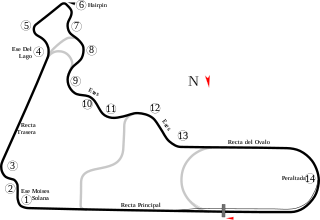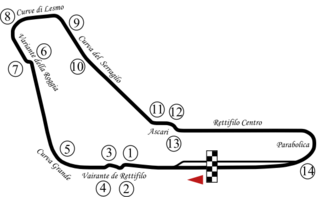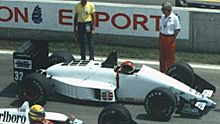
The 1988 Brazilian Grand Prix was a Formula One motor race held on April 3, 1988, at the renamed Autódromo Internacional Nelson Piquet in Rio de Janeiro. Following his 3rd World Drivers' Championship in 1987 the Jacarepaguá Circuit was named after local hero Nelson Piquet. It was the first race of the 1988 Formula One season.

The 1988 Belgian Grand Prix was a Formula One motor race held at the Circuit de Spa-Francorchamps on 28 August 1988. It was the eleventh race of the 1988 Formula One World Championship.

The 1988 Portuguese Grand Prix was a Formula One motor race held on 25 September 1988 at the Autódromo do Estoril, Estoril. It was the thirteenth race of the 1988 Formula One World Championship. The 71-lap race was won by Alain Prost, driving a McLaren-Honda, with Ivan Capelli second in a March-Judd and Thierry Boutsen third in a Benetton-Ford. Prost's teammate and Drivers' Championship rival, Ayrton Senna, could only manage sixth.

The 1989 Brazilian Grand Prix was a Formula One motor race held at Jacarepaguá, Rio de Janeiro on 26 March 1989. It was the first race of the 1989 Formula One World Championship.

The 1989 Mexican Grand Prix was a Formula One motor race held at the Autódromo Hermanos Rodríguez, Mexico City on 28 May 1989. The race, contested over 69 laps, was the fourth race of the 1989 Formula One season and was won from pole position by Ayrton Senna, driving a McLaren-Honda, with Riccardo Patrese second in a Williams-Renault and Michele Alboreto third in a Tyrrell-Ford.

The 1989 Italian Grand Prix was a Formula One motor race held at Monza on 10 September 1989. It was the twelfth race of the 1989 Formula One season.

The 1989 Spanish Grand Prix was a Formula One motor race held at Jerez on 1 October 1989. It was the fourteenth race of the 1989 Formula One World Championship. The 73-lap race was won from pole position by Ayrton Senna, driving a McLaren-Honda. Gerhard Berger was second in a Ferrari, while Senna's teammate and Drivers' Championship rival Alain Prost was third.

The 1990 United States Grand Prix was the opening motor race of the 1990 Formula One World Championship held on March 11, 1990, in Phoenix, Arizona. It was the 32nd United States Grand Prix since the American Grand Prize was first held in 1908, and the 25th under Formula One regulations since the first United States Grand Prix was held at Sebring, Florida in 1959. It was the second to be held on the streets of Phoenix and ran over 72 laps of the 4 km-circuit.

The 1990 Brazilian Grand Prix was a Formula One motor race held at Interlagos, São Paulo on 25 March 1990. It was the second race of the 1990 Formula One World Championship. It was also the first Brazilian Grand Prix to be held at Interlagos since 1980, following the renovation and shortening of the circuit and the ascendancy of São Paulo driver Ayrton Senna.
The 1990 Canadian Grand Prix was a Formula One motor race held on 10 June 1990 at Circuit Gilles Villeneuve. It was Race 5 of 16 in the 1990 Formula One World Championship. It was the 28th Canadian Grand Prix and the 12th to be held at the Circuit Gilles Villeneuve. The race was held over 70 laps of the 4.390 km (2.728 mi) circuit for a race distance of 307 kilometres.

The 1990 Mexican Grand Prix was a Formula One motor race held at Autodromo Hermanos Rodriguez on 24 June 1990. It was sixth race of the 1990 Formula One World Championship, the 14th Mexican Grand Prix and the fifth since the Mexico City circuit returned to the Formula One calendar in 1986. It was held over 69 laps of the 4.4 kilometre circuit for a race distance of 305 kilometres.

The 1990 Spanish Grand Prix was a Formula One motor race held at Jerez on 30 September 1990. It was the fourteenth race of the 1990 Formula One World Championship, and the fifth and last Spanish Grand Prix to be held at Jerez.

The 1990 FIA Formula One World Championship was the 44th season of FIA Formula One motor racing. It featured the 1990 Formula One World Championship for Drivers and the 1990 Formula One World Championship for Constructors, which were contested concurrently over a sixteen-race series that commenced on 11 March and ended on 4 November. Ayrton Senna won the Drivers' Championship for the second time, and McLaren-Honda won their third consecutive Constructors' Championship.
Stefano Modena is a former racing driver from Italy. He participated in 81 Formula One Grands Prix, debuting on November 15, 1987. He achieved 2 podiums, and scored a total of 17 championship points.
Oscar Rubén Larrauri is a racing driver from Argentina. He participated in 21 Formula One Grands Prix, all with the EuroBrun team, debuting at the 1988 Brazilian Grand Prix. He scored no championship points, only qualifying 8 times.
Onyx Grand Prix is a former Formula One constructor from Britain that competed in the 1989 and 1990 Formula One seasons. The team participated in 26 World Championship Grands Prix and scored six World Constructors' Championship points. Its best result was third place, in the 1989 Portuguese Grand Prix, for Stefan Johansson.

The Brabham BT58 was a Formula One racing car designed by John Baldwin and Sergio Rinland for the Brabham team which raced in the 1989 season. The teams cars were driven by Italian Stefano Modena and the 1988 World Sportscar Champion, the returning Martin Brundle. It made its debut at the 1989 Brazilian Grand Prix and continued until the first two races of 1990. The best result achieved was a third place at the 1989 Monaco Grand Prix driven by Modena. The car was powered by the Judd V8 engine and ran on Pirelli tyres.

The EuroBrun ER188 was a Formula One car built and raced by the EuroBrun team for the 1988 Formula One season. The car was designed by Mario Tolentino and was powered by a normally aspirated Cosworth DFZ engine. Three ER188 chassis were produced.

The EuroBrun ER189 and ER189B were Formula One cars built and raced by the EuroBrun team for the 1989 and 1990 Formula One seasons. The cars were designed by George Ryton and were powered by a normally aspirated Judd EV engine.

The EuroBrun ER189B is the last Formula 1 single-seater entered by the EuroBrun Racing team in its final participation in the Formula 1 World Championship, in 1990.














